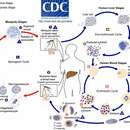en
names in breadcrumbs


Plasmodium knowlesi, which usually infects monkeys (e.g., Macaca fascicularis, M. nemestina, and Saimiri sciureus), is one of the five described Plasmodium species that cause malaria in humans (with Plasmodium falciparum generally causing the most severe disease and most of the mortality from the disease). Until recently, Plasmodium knowlesi malaria in humans was misdiagnosed as the less dangerous Plasmodium malariae malaria (molecular diagnostic techniques are important, since confusion with P. malariae is easy using conventional microscopy). Like P. falciparum, P. knowlesi can cause severe and even fatal cases of disease that are more severe than those caused by the other Plasmodium species. Human infections are widely distributed across Malaysian Borneo and extend to Peninsular Malaysia; several cases have been reported in other Southeast Asian countries, and a few cases have been reported in travelers visiting these areas, raising concerns about this parasite spreading to new areas. Because P. knowlesi replicates every 24 hours, rapid diagnosis and prompt effective treatment are essential. The most effective mosquito vector is represented by Anopheles latens; this mosquito is a parasite of both humans and monkeys. (Cox-Singh et al. 2008; Sabbatani et al. 2010; Kantele and Jokiranta 2011)
The human malaria parasite life cycle involves two hosts, a mosquito and a human. The life cycle is very complex, including both sexual and asexual phases (see life cycle diagram) and involves a stage in the liver as well as the blood stage, the latter being responsible for the clinical manifestations of the disease. (Centers for Disease Control Parasites and Health website)
There are more than 150 named species of Plasmodium that infect various species of vertebrates. Four species are well known as true parasites of humans, utilizing humans almost exclusively as a natural intermediate host: P. falciparum, P. vivax, P. ovale and P. malariae. In recent years it has become apparent that the simian malaria parasite P. knowlesi also regularly infects humans, as well as its natural monkey intermediate hosts. (Centers for Disease Control Parasites and Health website) Furthermore, it is now apparent that there are likely two distinct Plasmodium species that have both been referred to as P. ovale (Sutherland et al. 2010; Oguike et al. 2011).